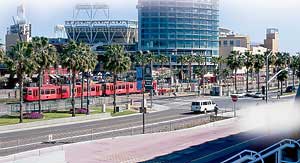 |
| SAN DIEGO (Photo by Michael Goodman for ENR) |
Deliberately using sports venues as "locomotives to create a sense of place and destination in a no-mans land" is "revolutionary thinking," says Marc Salette, a partner in Gehry Partners, Los Angeles, master planner and architect for a proposed $2.5-billion, mixed-use arena village in Brooklyn, N.Y.
|
Others agree. The sports village is "absolutely fabulous news" for smart growth, transit-oriented development, urban renewal and delivery of public services and infrastructure, says Peter Hall, president of San Diegos wholly owned Center City Development Corp. CCDC is a partner in a baseball village anchored by the Padres $452.6-million PETCO Park, opening April 8 (see p. 26).
For some 15 years, cities, including Baltimore, Denver, Cincinnati and Pittsburgh, have been saying "not in my back yard" to insular stadiums in the suburbs, plopped like alien spacecraft in a sea of asphalt. Instead, they built on the fringes of downtown, figuring the sports venue would trigger economic revitalization. Pittsburghs North Shore is an example of this, but with two facilities.
San Diego was the first to take a less-haphazard approach. Officials are not only requiring the Padres to bear financial risk for the ballpark, they are requiring the team to develop surrounding real estate. Incremental taxes from that will pay for the citys investment. "In that way, we get two bangs for the buck," says Bruce Herring, deputy city manager.
The results "far exceed everybodys expectations," says John Moores, chairman of the Padres and JMI Realty, the citys master developer for the 26-block ballpark village, part of the East Village.
JMI expects to achieve nearly $600 million in ancillary development in the ballpark village alone, which is almost twice its obligation. The neighborhood is abuzz with building. Land values in the underutilized warehouse district have soared from $35 to $200 per sq ft. And economists predict more than $3 billion in development in the 100-block East Village by 2020, according to Charles E. Black, president of Padres Construction.
The Padres victory has not been easy. The job went into "extra innings" as a result of more than 15 lawsuits and a federal inquiry. That aside, the deals are "quite onerous for the developer, and the city [was] extremely hard to deal with," says Moores.
But it proves that "if it can be done in San Diego, it can be done anywhere," he says, offering the project as a guide to other cities considering a sports village.
click below to view more articles from this special report >>
San Diego's Ballpark Neighborhood Is a Grand Slam Against Slums
$2.5-Billion Brooklyn Minicity Could Create Exclusive New Address
core one for the urban sports village. City boosters have finally figured out that these "reality" theme-parks-plus, with no price of admission or lock-out gates, are more than magnets for living, working and watching basketball, baseball or football. They are a quick creation of address cachet in blighted areas.